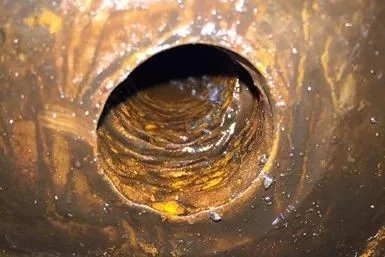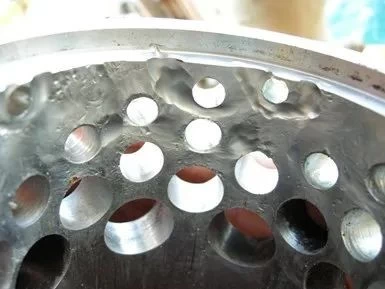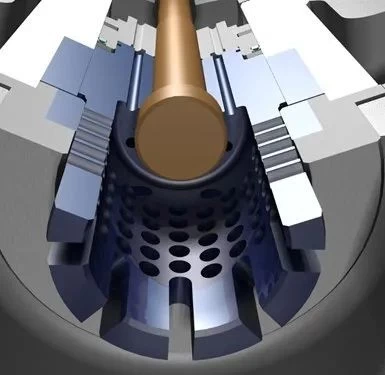Handling sand erosion in control valves and throttle valves
Handling sand erosion in control valves and throttle valves
Sand erosion in control valves and throttle valves is a significant consideration offshore. Sand can erode valve internals and pressure envelopes. While nothing can fully withstand sand erosion, carefully selected valves and internals can extend their service life and maximize maintenance intervals.
Although sand may be present in many offshore systems, most issues related to sand erosion occur around the wellhead or separator systems.

Modulated control valves or throttle valves manage pressure drop by controlling the area of the valve internals. The closer the plug is to the valve seat, the more restrictive the valve internals become, resulting in a higher velocity of fluid passing through the valve. Ultimately, the higher the velocity of fluid containing sand, the faster the erosion. Therefore, when sand is present, slower fluid velocity is better.
The fluid velocity through the valve can be simply reduced by maximizing the flow passage. Larger-sized valves with bigger openings are typically preferred, but they come at a higher cost. The most suitable valve size should be chosen by considering both pressure drop and fluid velocity.
Valve Body Style
In the presence of sand, the optimal valve body style is an angle valve, as it can direct solids into the downstream pipeline, reducing the impact on the valve body walls.
In some cases, angle valves cannot be used, and a globe valve is specified instead. When using a globe valve, the fluid should always flow above the valve plug, which eliminates direct impact on the body walls. A seat diffuser can provide additional protection by preventing the fluid from directly striking the bottom of the ball once the valve internals experience a pressure drop.
Internals Design
Single-stage cage-style designs are highly suitable for contaminated service. First, they are low-pressure recovery designs, and second, they have simplified flow paths.
The fluid flows from the outside to the inside, meaning the fluid jets collide at the center of the cage, ensuring energy is reduced with minimal contact with the metal surfaces.
In contaminated service, the use of multi-stage valve internals with 90-degree bends should be avoided when possible, as sand can get trapped at the 90-degree turns. Depending on the amount of sand, the valve can quickly become blocked.

In cases where multi-stage valve internals are required, valves for harsh service conditions are typically specified. Care should be taken when selecting these internals, as most designs rely on processes involving 90-degree bends. It is important to choose multi-stage internals specifically designed for handling solids, which will allow debris (such as sand) to pass through without causing blockages. Valve internals designed with an inlet flow path larger than the outlet flow path are discouraged, as they may clog. Instead, internals with a minimum opening at the fluid inlet should be used.
Tungsten Carbide
As mentioned above, sand causes erosion by impacting material surfaces. Therefore, the harder the material surface, the lower the erosion rate. Tungsten carbide is commonly used in these cases due to its relative hardness. Solid tungsten carbide inserts are used in areas with the highest corrosion potential, such as valve cages, plugs, and seats. Solid tungsten carbide can be used, but compression loads within the valve may cause it to crack.
In some cases, ceramic materials can be used, but most specifications in the oil and gas industry require tungsten carbide.
One significant disadvantage of tungsten carbide is its brittleness. It is similar to bathroom tiles: very abrasion-resistant, but prone to breaking if dropped. Therefore, embedding the carbide in a steel casing is beneficial. In the valve cage, the steel outer cage also acts as a "brick barrier," preventing damage from large debris in the pipeline.
To prevent stress points that could lead to cracking and failure of the carbide portions, tungsten carbide must be carefully designed.
When using tungsten carbide, cavitation must be avoided. Cavitation can erode the binder that holds the carbide particles together. It can also create shock cells and lead to vibration. Since carbide is very brittle, cavitation can result in catastrophic component failure.

Severe service valve internals based primarily on metal to metal seat butterfly valve disc stacking technology can be made from solid tungsten carbide. However, several design factors must be considered. For example, the valve discs need to be approximately 6-10 mm thick due to the characteristics of carbide during the manufacturing process. If the valve discs are thinner, they are more likely to crack. In most cases, tungsten carbide valve discs must be stacked (bonded) together to increase strength.
Modern Computational Fluid Dynamics (CFD) technology can be used to simulate sand erosion and particle tracking. This can simulate the flow patterns within a valve, and then track the sand particles through the flow domain.
At the first North American Multiphase Technology Conference held in Banff, Canada, in 1998, Det Norske Veritas provided an erosion rate equation for a small partition in the paper "Predicting Sand Erosion in Process and Pipeline Components," which is derived from the total impact of all particles striking that defined area. This method can be used to predict the lifespan of valve internals. For example, if a client is concerned about the safety of a valve during a leak event and wishes to install a flow restrictor, the corrosion rate of the restrictor can be calculated to determine the maintenance interval.
Offshore operations present many challenges, but controlling sand and particle erosion ensures the longevity of components and minimizes costly interventions, thereby ensuring maximum oil and gas production.
 +86 512 68781993
+86 512 68781993 


















